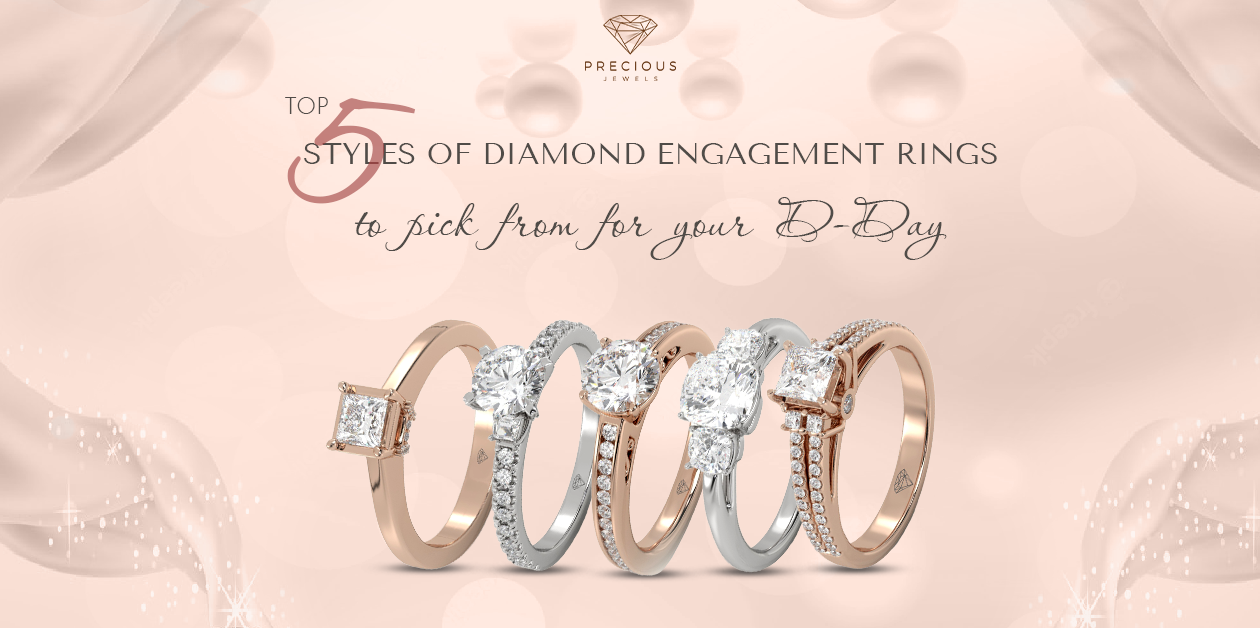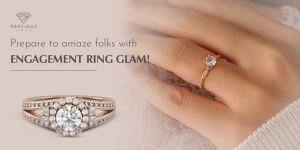
Purchasing a diamond engagement ring involves much more than simply walking into a store, looking around for your favorite, and leaving with it. A variety of aspects influence the final choice.
Ahead, we’ve outlined all you need to know about the purchase of engagement rings and the most common setting choices to help you in your quest. With some thoughtful suggestions, you’ll be able to decide which of a diamond’s many characteristics is most significant to you. So, When it comes time to make that lavishing purchase, knowing that you made the most fantastic decision possible will make you feel more confident.
Everything one should know about diamond engagement ring settings.
How does one pick the best diamond ring setting?
- The ideal diamond ring setting relies on the center stone and your personal preferences. While most traditional diamond engagement ring Antwerp settings typically have four prongs keeping the stone in place, you might want to choose additional if the diamond is larger or has a fancy cut shape.
- Choosing the best diamond ring setting depends on your daily routine as well. A high-set diamond (one that sits higher on your hand) can make your stone more vulnerable to chipping or, worse, falling out; if you lead an active lifestyle or constantly work with your hands, try not to choose a ring with larger stones. Instead, a lower setting may be safer.
- You can choose this with others if you feel stuck between decisions. Any seasoned gemologist or jeweler can assist you in selecting a setting that is appropriate for your requirements. You may choose a wholly unique setting if you wish for something more Unique.
Which setting would make my ring look large?
- Overall, every Engagement ring setting might make a diamond appear larger if you strive for a bold style. But here’s a thing, the more you want, the shimmer, the more you have to pay. But you can achieve the sparkle you dream of by playing around with the elements of the rings. You can choose a smaller center stone with a large setting to make it appear larger than it is. Any halo setting with lesser stones surrounding the diamond will amplify the central stone and make it appear larger to the unaided eye.
- The ring will appear larger if the side stones are more numerous so you can choose settings like a three-stone ring.
- Other diamond ring settings can also make your ring glitter more. Think of a pavé band or a solitaire stone with a secret halo if you want your ring to look incredibly sparkling. Smaller diamonds on bands will make your ring appear brighter because they will shine on it from all sides, bringing all the focus to the dazzling center stone.
Classic Engagement Ring Styles.
Setting vs Style
Many times a person needs clarification on these two terms. So, before we delve into the different types of settings someone is likely to encounter when searching for an engagement ring, let’s know the difference between Style and Setting.
We use the word “style” to describe how a ring feels and looks.
A ring technically consists of two components: the head, or gallery, which holds the diamond in place, and the shank, or body, of the ring. Beyond only protecting your diamond, the setting has other benefits. It’s a crucial aspect of the diamond’s appearance.
The “setting” refers to the overall ring, specifically how the diamonds are mounted or held on the ring. The “head,” or the portion of the ring that is on top and has the diamonds, and the “shank,” or the portion of the band that wraps around the finger, make up a ring setting.
“The setting not only secures and safeguards the center stone but also enhances the appearance and feel of your engagement ring.”
Simply put, every engagement ring has a setting, but how it appears on the finger depends on your chosen style of setting. However, the fact that your setting is made to keep your center stone secure is what counts most.
Here is a guide to the fundamental types of ring settings.
-
Solitaire Engagement Ring:
Even though so many settings are taking market and couples with a surprise, there’s nothing compared to a Solitaire Engagement Ring. The solitaire ring is the most popular diamond engagement ring in Antwerp style that showcases a single magnificent diamond at the heart of the band. It is one of the most exquisite and timeless types ever. This engagement ring is frequently paired with a prong setting, in which several prongs retain the central stone as it sparkles on all sides. This arrangement has a lovely appeal because of its simplicity and timelessness, highlighting the center solitaire’s brilliance and shine. You can select from various fancy-shaped diamonds and match them with a band to glam up your ring.
-
Halo Engagement Ring:
In terms of ring designs, the halo style has gained popularity recently. This type of diamond engagement ring Antwerp design, which has a magnificent center stone surrounded by a glittering halo of tiny diamonds, embraces maximum dazzle. Another design of the diamond engagement ring Antwerp that adds more glitter to any band is the Halo, available in various
s sizes and shapes. When embellished, the smaller stones encircling the stone enlarge the diamond in the middle. The most common diamond cuts in halo ring designs are pear and oval.
-
Pave Engagement Ring:
A pavé setting is the third most popular type of engagement ring setting. A pavé diamond setting name, taken from the French term for “paved,” entails rows of numerous little stones put into holes that elevate them to level with the ring’s surface.
It is a sparkling setting resembling a road covered in precious stones. Therefore, a pavé setting can provide an attractive pop of shine without taking away the focus from the center stone. The many pavé diamonds were placed together to produce a stunning engagement ring with tons of sparkle.
These settings provide more brilliance without drawing attention away from the central diamond. However, because of the complexity of this diamond engagement ring Antwerp setting style, you should deal with a skilled jeweler. Pavé settings demand skilled craftsmanship and careful attention to detail because they are delicate.
-
Three Stones Engagement Ring:
The three-stone engagement ring style, the trilogy ring, is ideal for marking important life events and milestones. These trilogy stone ring designs frequently represent a partnership’s past, present, and future. As the name implies, a three-stone setting has a center diamond and two side diamonds. Typically, the side diamonds are smaller than the center stone, which enhances the attraction of the ring’s overall appearance. Princess and oval cut diamonds are the most popular fancy diamonds in this diamond engagement ring Antwerp setting.
-
Tension Setting Engagement Ring:
In a tension-setting engagement ring, the stone is held firmly in place by the compression-spring pressure of the shank. The stone may appear floating due to the low interference of metal. Only extremely hard stones are advised for this diamond ring setting since they can endure the pressure needed to keep them securely in place. One thing to remember is that because this design is made specifically to accommodate the center stone, later sizing may be challenging. Despite this, it’s one of the unique settings, which makes it perfect for wearers looking for something completely different.

Prepare to amaze folks with Engagement Ring Glam!
One of life’s most memorable purchases is a diamond engagement ring, so take your time and make a wise decision. When you finally find the dream ring, get it from a reputable source with a certified diamond.
All of our parts is done now. The experts at Precious Jewels have provided these recommendations and advice, and they can also help you if you’re willing to buy dazzling jewelry pieces.
You can always rely on Precious Jewels to help you choose a perfect diamond engagement ring because they have the most magnificent and brilliant jewelry for that particular someone. Visit their website to find the most lovely diamond ring that precisely complements your partner’s character traits. Hurry up!! Your one-of-a-kind engagement ring is waiting to Glam!!

Great post.